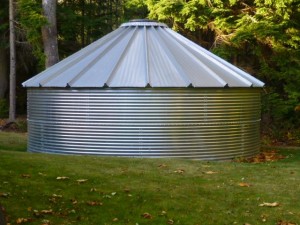 Collecting the rain makes better sense than complaining about it. Whether you collect it in rain barrels or your storage needs require larger cisterns, rainwater collection and use has a host of benefits. Here is why you should change your way of thinking about rainwater collection:
Collecting the rain makes better sense than complaining about it. Whether you collect it in rain barrels or your storage needs require larger cisterns, rainwater collection and use has a host of benefits. Here is why you should change your way of thinking about rainwater collection:
Rainwater can be a clean, safe, reliable source of potable and non potable water. Rainwater is relatively clean to begin with and if collected, conveyed, stored, filtered and disinfected properly, it can meet the needs of small scale watering to whole house potable use.
Rain barrels can collect water inexpensively for small watering needs, with down spouts being diverted to a rain garden when full, as well as during the rainy season.
Larger cisterns can collect water all winter long to have a large volume for irrigation needs during the summer months. If collected water is pressurized and filtered, it can be plumbed into toilet facilities and laundry to supplement city water usage. If filtered and disinfected, whole house potable usage can be achieved whether large cisterns are used for year-round use or as small storage as a supplement to city water.
So, instead of saying “DARN RAIN!!!!”, consider changing your way of thinking about rainwater collection.



 With the new “Green Storm Water Infrastructure” or
With the new “Green Storm Water Infrastructure” or  Cement water tanks are not naturally waterproof; cracks in concrete can result years after construction. The use of a liner, whether spray on epoxy, or a poly bag will prevent groundwater from entering the water tank as well as improve water quality.
Cement water tanks are not naturally waterproof; cracks in concrete can result years after construction. The use of a liner, whether spray on epoxy, or a poly bag will prevent groundwater from entering the water tank as well as improve water quality.
 The GSI mandate or “
The GSI mandate or “ Directing roof runoff for irrigation, toilets, laundry, or even pre-infiltration potable water, will reduce costs from municipal water supplies. During the rainy season, collected water can supply these uses while overflow from the cistern can be directed to infiltration. Irrigation in the summer months being supplied by the desired amount allocated from storage will enable the rain garden or infiltration system to be sized for a smaller amount of runoff while supplementing city water usage.
Directing roof runoff for irrigation, toilets, laundry, or even pre-infiltration potable water, will reduce costs from municipal water supplies. During the rainy season, collected water can supply these uses while overflow from the cistern can be directed to infiltration. Irrigation in the summer months being supplied by the desired amount allocated from storage will enable the rain garden or infiltration system to be sized for a smaller amount of runoff while supplementing city water usage.